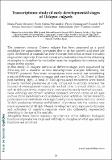Por favor, use este identificador para citar o enlazar a este item:
http://hdl.handle.net/10261/227417COMPARTIR / EXPORTAR:
 SHARE
BASE SHARE
BASE
|
|
| Visualizar otros formatos: MARC | Dublin Core | RDF | ORE | MODS | METS | DIDL | DATACITE | |

| Título: | Transcriptomic study of early developmental stages of Octopus vulgaris |
Autor: | Prado-Álvarez, María CSIC ORCID; García-Fernández, Pablo; Domingues, Pedro; Tur, R.; Hachero-Cruzado, Ismael; Dios, S. CSIC ORCID ; Varó, Inmaculada CSIC ORCID; Gestal, C. CSIC ORCID | Fecha de publicación: | 16-sep-2020 | Resumen: | The common octopus Octopus vulgaris has been proposed as a good candidate for aquaculture operations due to its fast growth and short life cycle. Settlement of animals has been the main bottleneck to reach the adult stage under captivity. However, recent achievements have allowed the obtaining of samples to decipher the molecular basis that regulates the intricate early stages in this species. In this study, O. vulgaris samples at different stages were sequenced by RNA-seq for a massive de-novo transcriptomic analysis following the TRINITY protocol. Four main comparisons were carried out considering a mix of different embryonic stages and paralarvae at 0, 10, 20 and 40 days post-hatching (dph). A total of 2300 up-regulated transcripts were found in newly hatched paralarvae (0 dph) compared to embryo whereas the number of overexpressed transcripts reached 2336, 3013 and 2580 in 10, 20 and 40 dph paralarvae, respectively, compared to newly hatched animals. Gene ontology enrichment analysis revealed common terms at all ages such as chitin metabolism and peptidase related activities. Terms related to proteolysis and catabolism were significantly more represented in 0, 10 and 20 dph paralarvae whereas mobilization of proteins into the nucleus was more represented at 40 dph. Neural development and response to stimulus and activation of immune response were also differently represented attending to the age of the animals. Altogether these results represent an overview of the different biological functions at paralarvae stage and will help to decipher at what age relevant functions are activated. | Descripción: | Comunicación presentada en CephRes2020 Virtual Event Biology and Life History of Cephalopods, celebrado de manera virtual del 16 al 21 de septiembre de 2020. | URI: | http://hdl.handle.net/10261/227417 |
| Aparece en las colecciones: | (IATS) Comunicaciones congresos (IIM) Comunicaciones congresos |
Ficheros en este ítem:
| Fichero | Descripción | Tamaño | Formato | |
|---|---|---|---|---|
| Transcriptomic_Prado_ComCong2020.pdf | 271,55 kB | Adobe PDF |  Visualizar/Abrir |
CORE Recommender
NOTA: Los ítems de Digital.CSIC están protegidos por copyright, con todos los derechos reservados, a menos que se indique lo contrario.
